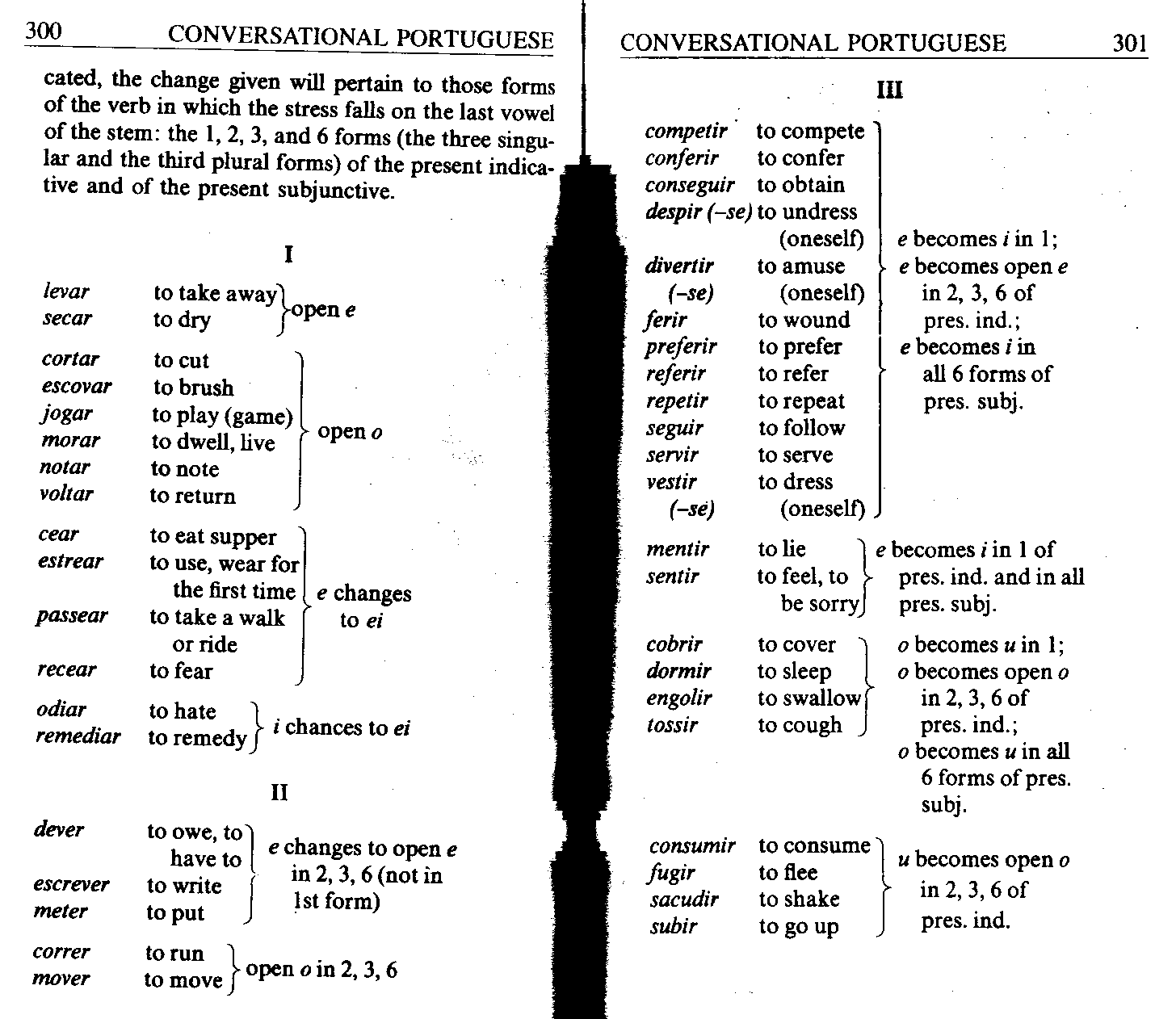Summary p300

300 CONYERSATIONAL PORTUGUESE
cated, the change given will pertain to those forms of the verb in which the stress falls on the last vowel of the $tem: the 1,2, 3, and 6 forms (the three singu-lar and the third plural forms) of the present indica-tive and of the present subjunctive.
I
levar
secar
cortar
escovar
jogar
morar
notar
vołtar
cear
estrear
passear
recear
odiar
remediar
to take away todry
open e
tocut tobrush to play (gamę) to dwell, live to notę to return
► open o
to eat supper to use, wear for thefirsttime ^ to take a walk [ or ride to fear
e changes to ei
to hate \ to remedy J
i chances to ei
II
dever
escrever
meter
correr
mover
e changes to open e in 2,3,6 (not in Ist form)
to owe, to' have to to write to put
to run 3 . ~ ,
4 > open o in 2,3, o
tomovej
Iii

consumir
fugir
sacudir
subir
e becomes i in 1; e becomes open e in 2, 3, 6 of pres. ind.; e becomes i in all 6 forms of pres. subj.
competir to compctc' conferir to confer conseguir to obtain despir (-se) to undress (oneself)
divertir to amuse (-se) (oneself)
ferir to wound
preferir to prefer
referir to refer
repetir to repeat
seguir to follow
servir to serve
vestir to dress
(-se) (oneself) „
|
mentir |
tolie "1 |
e becomes i in 1 of |
|
sentir |
tofeel, to |
*• pres. ind. and in all |
|
be sorryj |
pres. subj. | |
|
cobrir |
to cover ' |
o becomes u in 1; |
|
dormir |
to sleep |
o becomes open o |
|
engolir |
to swallow |
in 2,3,6 of |
|
tossir |
tocough ^ |
pres. ind.; |
o becomes u in all 6 forms of pres. subj.
to consume" toflee to shake to go up
u becomes open o in 2,3,6 of pres. ind.
Wyszukiwarka
Podobne podstrony:
Summary p240 240 CONYERSATIONAL PORTUGUESE 14. THE PLURAL 1. Nouns ending in a vowel, including na
Summary p282 282 CONYERSATIONAL PORTUGUESE 3. When the “if* clause expresses a d
Summary p302 302 CONYERSATIONAL PORTUGUESE 42. SPELLING CHANGES IN YERBS Some verb forms, as is tr
Summary p230 230 CONYERSATIONAL PORTUGUESE 3, The cedilla (cedilha) is used with
Summary p234 234 CONYERSATIONAL PORTUGUESE k. with parts of the body and articles of clothing inst
Summary p236 236 CONYERSATIONAL PORTUGUESE De and em combine with the demonstrative forms (see GS2
Summary p258 258 CONYERSATIONAL PORTUGUESE 23. ADYERBS 1. Some Portuguese adverbs are formed by ad
Summary p266 266 CONYERSATIONAL PORTUGUESE27. NEGATION 1. Ndo “not” comes before
Summary p268 268 CONYERSATIONAL PORTUGUESE 2. The personal infinitiye has endings which make it ea
Summary p284 284 CONYERSATIONAL PORTUGUESE finał a changed to e and finał e changed to a (but also
Summary p288 288 CONYERSATIONAL PORTUGUESE Although both forms are used, therc is a tend-ency for
Summary p292 292 CONYERSATIONAL PORTUGUESE O cafe estd frio. A janela estd aberta (fechada). Ela e
Summary p304 304 CONYERSATIONAL PORTUGUESE Some of the other verbs in -gar: apagar to put out, e
Summary p306 306 CONYERSATIONAL PORTUGUESE 7. Verbs ending in -guer ot -guir In these verbs gu cha
Summary p222 222 CONYERSATIONAL PORTUGUESE 21. Vamos_(to have dinner). a. jantar
Summary p224 224 CONYERSATIONAL PORTUGUESE (3) variations occur in different areas: a.
Summary p226 226 CONYERSATIONAL PORTUGUESH CONYERSATIONAL PORTUGUESE 227 d g g h j I I Ut m as d i
Summary p238 238 CONYERSATIONAL PORTUGUESE 13. MASCULINE AND FEMININE 238 CONYERSATIONAL PORTUGUES
Summary p242 242 CONYERSATIONAL PORTUGUESE seu can also be used to translate “his,” “her,” “their.
więcej podobnych podstron